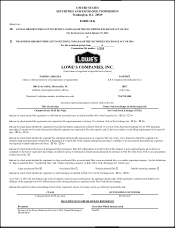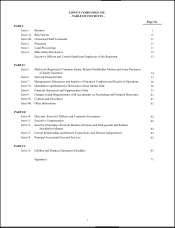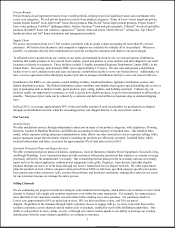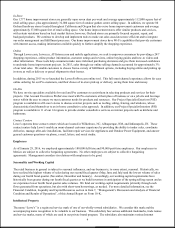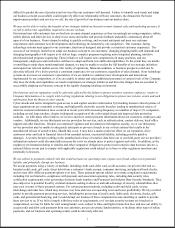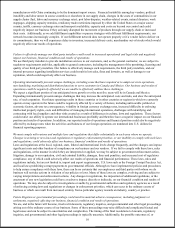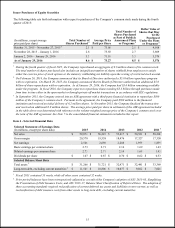Lowe's 2015 Annual Report Download - page 16
Download and view the complete annual report
Please find page 16 of the 2015 Lowe's annual report below. You can navigate through the pages in the report by either clicking on the pages listed below, or by using the keyword search tool below to find specific information within the annual report.
7
difficult to predict the mix of products and services that our customers will demand. Failure to identify such trends and adapt
our business concept successfully could negatively affect our relationship with our customers, the demand for the home
improvement products and services we sell, the rate of growth of our business and our market share.
We may not be able to realize the benefits of our strategic initiatives focused on omni-channel sales and marketing presence if
we fail to deliver the capabilities required to execute on them.
Our interactions with customers has evolved into an omni-channel experience as they increasingly are using computers, tablets,
mobile phones and other devices to shop in our stores and online and provide feedback and public commentary about all
aspects of our business. Omni-channel retailing is quickly evolving, and we must anticipate and meet our customer
expectations and counteract new developments and technology investments by our competitors. Our customer-facing
technology systems must appeal to our customers, function as designed and provide a consistent customer experience. The
success of our strategic initiatives to adapt our business concept to our customers’ changing shopping habits and demands and
changing demographics will require us to deliver large, complex programs requiring more integrated planning, initiative
prioritization and program sequencing. These initiatives will require new competencies in many positions, and our
management, employees and contractors will have to adapt and learn new skills and capabilities. To the extent they are unable
or unwilling to make these transformational changes, we may be unable to realize the full benefits of our strategic initiatives
and expand our relevant market access. Our results of operations, financial condition, or business prospects could also be
adversely affected if we fail to provide a consistent experience for our customers, regardless of sales channel, if our technology
systems do not meet our customers’ expectations, if we are unable to counteract new developments and innovations
implemented by our competitors, or if we are unable to attract and retain additional personnel at various levels of the Company
who have the skills and capabilities we need to implement our strategic initiatives and drive the changes that are essential to
successfully adapting our business concept in the rapidly changing retailing environment.
Our business and our reputation could be adversely affected by the failure to protect sensitive customer, employee, vendor or
Company information or to comply with evolving regulations relating to our obligation to protect our systems, assets and such
information from the threat of cyber-attacks.
Cyber-attacks and tactics designed to gain access to and exploit sensitive information by breaching mission critical systems of
large organizations are constantly evolving, and high profile electronic security breaches leading to unauthorized release of
sensitive customer information have occurred in recent years with increasing frequency at a number of major U.S. companies,
including several large retailers, despite widespread recognition of the cyber-attack threat and improved data protection
methods. As with many other retailers, we receive and store certain personal information about our customers, employees and
vendors. Additionally, we use third-party service providers for services, such as authentication, content delivery, back-office
support and other functions. Despite our continued vigilance and investment in information security, we or our third-party
service providers may be unable to adequately anticipate or prevent a breach in our or their systems that results in the
unauthorized release of sensitive data. Should this occur, it may have a material adverse effect on our reputation, drive
customers away and lead to financial losses from remedial actions, or potential liability, including possible punitive
damages. A security breach resulting in the unauthorized release of sensitive data from our or our third-party service providers’
information systems could also materially increase the costs we already incur to protect against such risks. In addition, as the
regulatory environment relating to retailers and other companies' obligation to protect such sensitive data becomes stricter, a
material failure on our part to comply with applicable regulations could subject us to fines or other regulatory sanctions and
potentially to lawsuits.
We are subject to payments-related risks that could increase our operating costs, expose us to fraud, subject us to potential
liability and potentially disrupt our business.
We accept payments using a variety of methods, including credit card, debit card, credit accounts, our private label and co-
branded credit cards, gift cards, direct debit from a customer’s bank account, consumer invoicing, and physical bank checks,
and we may offer different payment options over time. These payment options subject us to many compliance requirements,
including, but not limited to, compliance with payment card association operating rules, including data security rules,
certification requirements, rules governing electronic funds transfers and Payment Card Industry Data Security Standards. They
also subject us to potential fraud by criminal elements seeking to discover and take advantage of security vulnerabilities that
may exist in some of these payment systems. For certain payment methods, including credit and debit cards, we pay
interchange and other fees, which may increase over time and raise our operating costs and lower profitability. We rely on third
parties to provide payment processing services, including the processing of credit cards, debit cards, electronic checks, gift
cards, and promotional financing, and it could disrupt our business if these companies become unwilling or unable to provide
these services to us. If we fail to comply with these rules or requirements, or if our data security systems are breached or
compromised, we may be liable for card issuing banks’ costs, subject to fines and higher transaction fees, and lose our ability to
accept credit and debit card payments from our customers, process electronic funds transfers, or facilitate other types of online
payments, and our business and operating results could be adversely affected.




